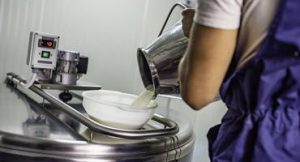
Nearly 75 years after Alvin and Milly Kinnard founded Kinnard Farms with 80 acres and 14 cows, the dairy and crop farming operation in eastern Wisconsin’s Door Peninsula employs scores and consists of around 8,000 cows, 7,000 additional heifers off-site, and roughly 10,000 acres between it and separate farmland assisting the business.
Kinnard Farm Inc.’s expansion reflects the post-mid-century trend from small family farms toward corporatized large-scale agribusiness. While in a way Kinnard is undoubtedly a success story, many condemn it and similar farms for the economic and environmental consequences inseparable from such growth.
Concentrated animal feeding operations (CAFOs), also known as factory farms, have exploded nationwide in recent decades, Kinnard being one example, and their market dominance is only increasing. The operations are basically defined by their large number of animals and how they are confined.
Factory farms can afford the expertise, manpower, technology and facilities to manage thousands of animals and acres of crops with mechanized efficiency. Smaller farms often cannot compete in this economy of scale, additionally hurt by changing consumer tastes and costly tariffs in a globalized marketplace.
Nationwide CAFO statistics are irregularly reported by federal agencies, but independent corroborative studies like one from the Natural Resources Defense Council in 2019 confirmed at least 7,500 CAFOs in 40 states, a fraction of the approximately 20,000 estimated based on EPA reports.
The Wisconsin Department of Natural Resources defines a CAFO as any animal feeding operation with at least 1,000 animal units or smaller ones which meet certain pollutant benchmarks. DNR currently reports 327 permitted CAFOs in the state, most of which are dairies. In 1985, agency statistics show, there was one, and they have multiplied exponentially since, particularly in the 2000’s.
Meanwhile, Wisconsin has led the nation in recent years in farm foreclosures, with 48 farms filing for Chapter 12 bankruptcy from 2020 to 2021. Dairy farms—the state’s flagship industry contributing almost half to its overall $104 billion agriculture industry—have steadily shuttered at an alarming rate, with more than one-third of its dairies closing from 2011 to 2018. The U.S. Department of Agriculture said in February that Wisconsin’s farms total was down 300 in 2021 from the previous year.
The EPA delegates implementation and permitting of Clean Water Act oversight to DNR. In order to operate in Wisconsin, CAFOs need an approved Wisconsin Pollutant Discharge Elimination System (WPDES) permit from DNR to ensure proper planning, nutrient management and water quality protection.
Manure management is a chief issue for water quality control. In a commonplace practice called land-spreading, manure is liquefied with water and used to fertilize fields, since the nitrates, phosphorous and other compounds in manure make nutrient-rich fertilizers at controlled levels.
Large CAFOs, however, can produce as much waste as a small city, and when there is not enough nearby farmland for manure to be promptly used as fertilizer, it often gets stored in massive lagoons, some of which can be millions of gallons, that can fail and allow seepage into the groundwater.
Kinnard’s website details sustainability and manure management practices for its cows and fields of alfalfa, corn silage and triticale it says exceed regulatory requirements.
Over the last decade, the farm has been embroiled in litigation and bureaucratic grappling with DNR over these issues, which more recently has resulted in a legal dispute over recent modifications DNR made to Kinnard’s WPDES permit.
In 2012, Kinnard’s Kewaunee County neighbors opposed a DNR-approved WPDES permit allowing the farm to add another site and thousands of cows because it would worsen pollution of area private drinking water wells, a particular concern in the region due to its unique karst topography.
In part based on findings revealing half the wells in an adjacent town were unsafe to drink from due to E. coli and nitrates contamination, an administrative law judge overseeing the contested case hearing decided DNR could limit herd size and increase groundwater monitoring for Kinnard, including at off-site land-spreading fields.
After years of legal wrangling over DNR’s authority to impose such permit conditions, during which a settlement agreement was reached in the original contested case hearing, the Wisconsin Supreme Court last summer affirmed DNR’s explicit and broad authority to dictate the permit terms to protect Wisconsin’s waters.
After residents later in 2021 protested new permit conditions that would have capped Kinnard’s herd size at 21,000 animal units, DNR cut that number to around 11,000 in March and modified Kinnard’s groundwater monitoring requirements.
Kinnard sued DNR in April in Kewaunee County Circuit Court over the modified permit conditions. They said the “unreasonably low” herd-size cap stifles growth of its herd beyond current levels at the cost of competitive flexibility, the additional groundwater monitoring is expensive and unpracticable, and both violate the parties’ previous settlement agreement.
Not all experts agree CAFOs are the sole problem. Pete Nowak, a retired UW-Madison environmental sciences professor, said a study in which he participated found small and large farms had better manure management than medium-sized farms, often mom-and-pop operations spread thin by the need to compete with limited resources and human capital.
“You have to get rid of this stereotype that it’s large farms, it’s CAFOs, that are causing all the problems,” Nowak said, cautioning against a simplified good-guy-bad-guy outlook.
Melissa Scanlan, a professor at UW-Milwaukee’s School of Freshwater Sciences and director of the university’s Center for Water Policy, sees the manure management problem with CAFOs like Kinnard as rudimentary.
“There are certain contaminants where there are gradients for acceptable levels. Manure is not one of them,” she said. “No one has a right to put manure in anyone else’s drinking water, period.”
Adam Voskuil, an attorney with Midwest Environmental Advocates, a group that has participated in the agency and court proceedings between Kinnard and DNR, said while smaller farms can have manure management issues, “the biggest culprit is these mega-operations that are producing millions of gallons of untreated waste to be spread on fields.”
Voskuil and Scanlan both said that, in Wisconsin, part of the issue is legislation, pointing to a 2004 livestock facility siting law that restricts local governments’ power to regulate CAFOs and a 2011 law limiting state agencies from putting into permits any terms not explicitly required by a statute or rule.
Wisconsin also has a “right-to-farm law” protecting livestock outfits from nuisance lawsuits over things like odors and pollution. All 50 states have some version of the law.
Amid a decade of fighting in court, Voskuil pointed out that “the people of Kewaunee County are continuing to suffer with contamination of their private drinking water wells.”
“This has gone on for far too long,” he said.
Kinnard did not respond to multiple requests for interview. Taylor Fritsch, a lawyer with Milwaukee firm Michael Best & Friedrich representing the farm in the Kewaunee County Circuit Court lawsuit, also did not respond to a request for comment.
The Kewaunee County Circuit Court lawsuit, which narrowly deals with the settlement agreement from Kinnard and DNR’s previous contested case hearing and the new permit terms, has been stayed pending Kinnard’s petition for another hearing. If DNR gives the go-ahead, the state Division of Hearings and Appeals will assign an administrative law judge, more public hearings will be scheduled, and the fight will continue.

























